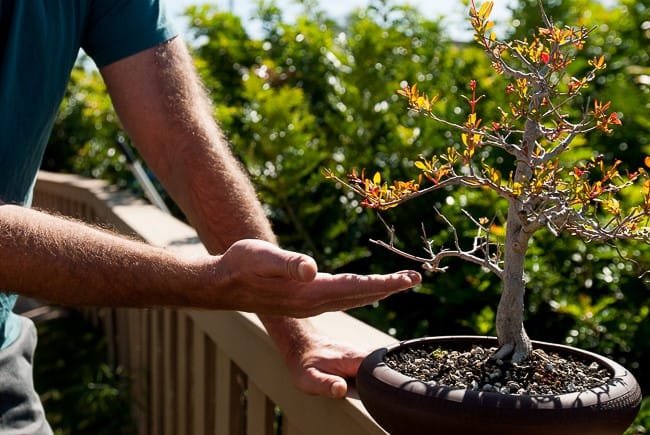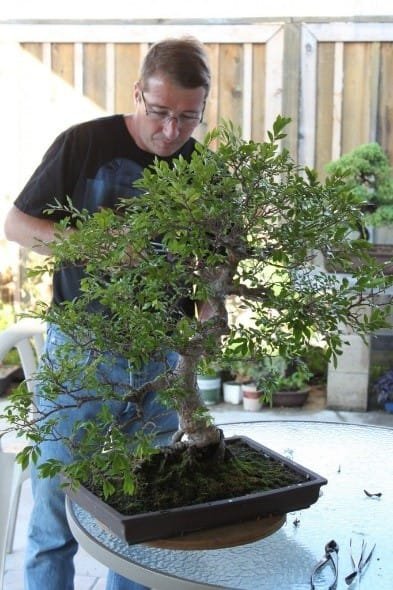Without the right tools, a bonsai tree gardener would be deprived of the opportunity to make the most out of the ancient practice of cultivating miniature trees that represent the entire spectrum of the living nature’s beauty and grace.
In fact, it would be fair to compare the lack of proper bonsai tools with the lack of the much-needed equipment that a surgeon needs to save people’s lives.
Let’s dive into exploring the top six essential bonsai pruning tools that make a tremendous difference in any bonsai practitioner’s journey while further discussing the advantages and usage of each of these instruments.
1) Scissors / Shears
Scissors or shears are important when it comes to cutting branches or twigs.
As a rule of thumb, it is best to pick scissors that match the thickness of the particular branch or twig that is about to be removed.
Heavy duty scissors are excellent for working with heavy branches but finishing fine cuts is much better accomplished with the use of trimming scissors. Trimming scissors are also great for trimming buds. With deciduous trees, maneuvering between leaves can be especially challenging but the thinner shape of trimming scissors makes this mission as easy as possible.
General purpose bonsai scissors can be also used when cutting roots, apart from branches.
2) Concave Branch Cutters
Concave branch cutters are hybrids of the function of knob cutters and branch cutters. Being a 2-in-1 tool, concave cutters. For bonsai practitioners who prefer functionality and simplicity, working with a single multipurpose tool might be an excellent choice.
High-quality concave branch cutters often tend to be expensive. However, it is good to keep in mind that their production takes a lot of skill – master concave branch cutters may spend up to 10 years in honing their skills and know-how as to produce nothing less but top-grade concave cutters.
3) Knob Cutters
Knob cutters possess spherically shaped cutting blades. Furthermore, knob cutters have a very particular use – they are meant to help bonsai gardeners in gouging out cut branches, including cases of fresh deadwood work.
Once carefully hollowed out after a cut, a bonsai tree can gradually achieve the desired shape.
Since working with deadwood is a very specific process, there are various carving tools and knives that are used with the clear purpose of accomplishing the exquisite deadwood effect that looks as natural as possible – with no trace of a bonsai gardener’s interference. For instance, a jin plier helps to pull the fibers on conifers, and a slim chisel that is not too sharp, though, can also be very helpful for lifting fibers.
Video by: Smart Pictvids – Deadwood on Bonsai
Source: youtube.com
4) Branch Cutters
When having to cut deep down to the very surface of the trunk, you need a better designed tool for this purpose than common scissors or shears.
Branch cutters will also help you avoid having to deal with a particularly raised area that may be the result of using the wrong tool.
The problem with a raised, swollen area on your bonsai is that it tends to become even more pronounced during the process of healing, and this can negatively affect the appearance of your miniature masterpiece.
Make sure that the blade of the branch cutter is approximately 1/3 of the length of the branch which is about to be cut. Therefore, you need to make use of different sized branch cutters accordingly. Or else, you may easily break the jaws of your branch cutter.
It is good to keep in mind that some branch cutters are created for the specific purpose of working on confined spots on your bonsai tree. Because of this, such branch cutters are much thinner than the ordinary models.
5) Wound Sealers
Despite the fact that wound sealers or pastes are often overlooked tools in pruning bonsai, they are perfect for speeding up the recovery process caused by the wounds you have intentionally made on your tree during the process of pruning.
Keep in mind that trees do not heal from the inside out, as highlighted in Tree Wounds: Response of Trees and What You Can Do, University of Tennessee. Instead, it is through the formation of a callus tissue how trees actually heal.
While there are DIY alternatives when it comes to wound sealing solutions, you may want to take advantage of a professional-grade sealer or paste, especially when it comes to working with conifers which are known to heal much more slowly, as opposed to deciduous varieties.
6) Root cutters
Although roots can be pruned with the use of common bonsai scissors or trimming scissors, root cutters are superior when re-potting your miniature masterpiece.
Apart from their suitability for trimming and grooming the roots properly, root cutters can be also utilized for reducing the size of branch stubs.
Ranking right next to the top six essential bonsai pruning tools, there are additional instruments that bonsai gardeners can greatly benefit from.
These include pruning saws that are well-suited to cutting trunks, roots or branches that are way too hard and/or thick to be addressed with the use of pliers.
Root hooks or rakes are needed when it comes to opening and combing the rootball. This is the best way to remove old soil that would otherwise remain stuck between the roots.
Let’s not forget that the roots of a bonsai tree are a critical part of the plant’s anatomy, and since the art of bonsai requires limiting the size of the tree into a miniature version, roots must be kept healthy at all times so that the tiny tree can recover easily from stress, training, and pruning.
Video by: DK Books – Bonsai: Styling Your First Bonsai Tree
Source: youtube.com
The Takeaway

Pruning a bonsai tree is one of the most frequently practiced aspects of bonsai cultivation. Selective removal of certain parts of the miniature plants is imperative in order to achieve the desired shape and appearance.
Since branches, buds, or roots need to be regularly maintained, we hope that the top six essential bonsai pruning tools we listed will be of your utmost assistance in enjoying and making the most of your journey through the art of bonsai.

